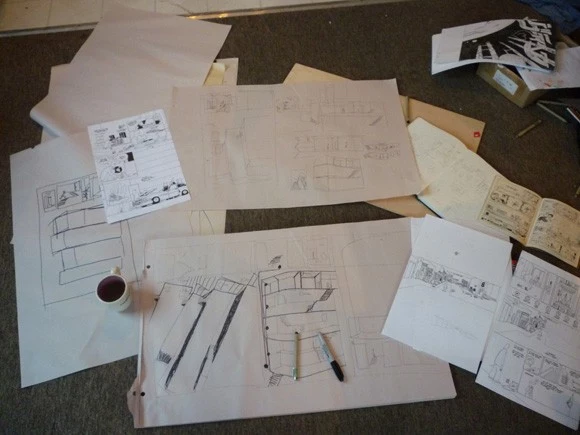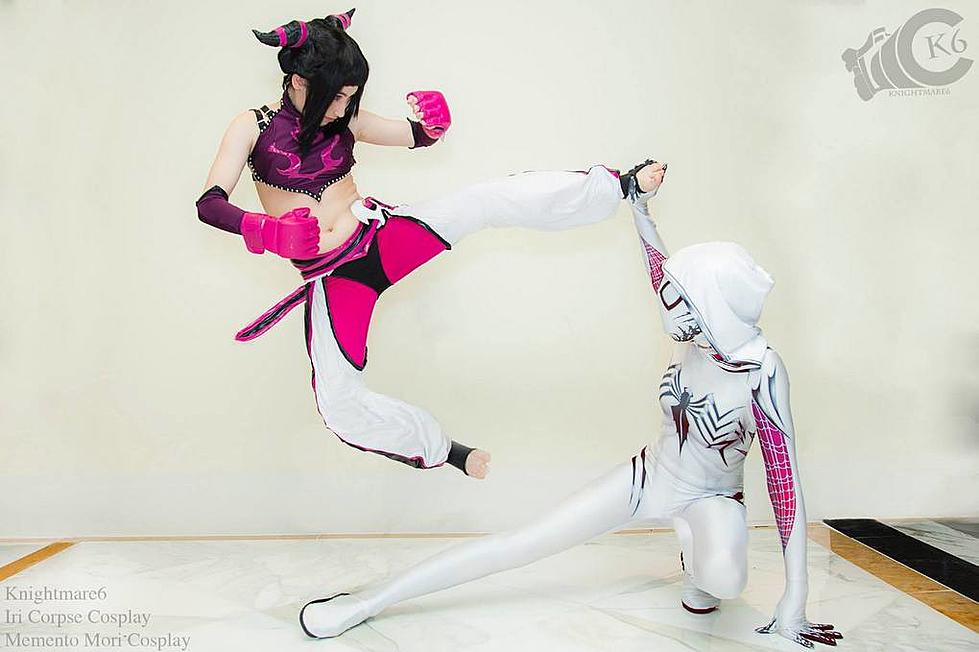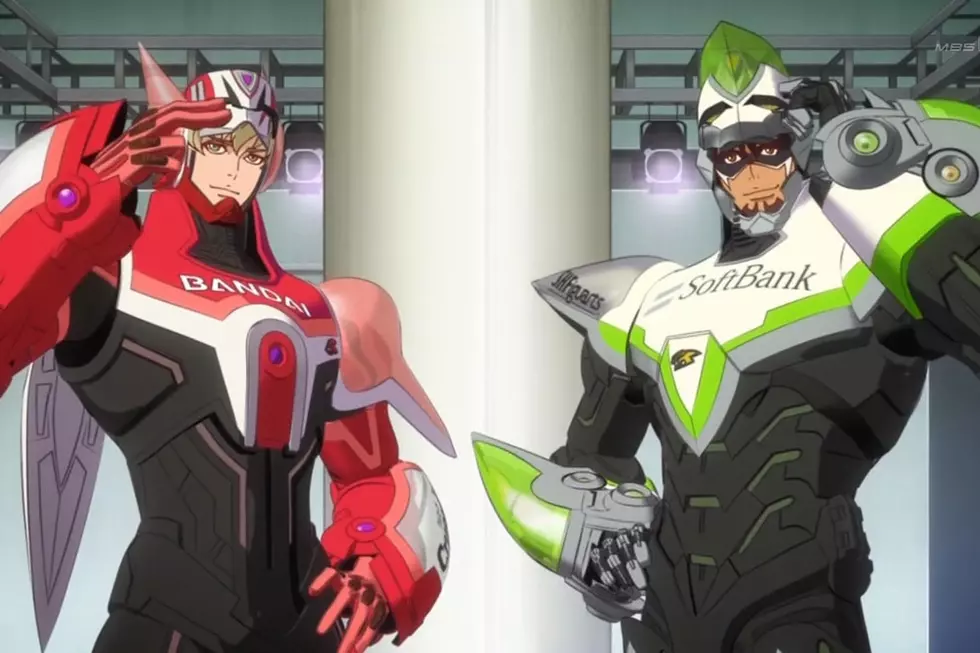
The Brandon Graham ‘Multiple Warheads’ Interview, Part 1 Of 2

This October, Brandon Graham (Prophet, King City)is unleashing the all-new color volume of his Multiple Warheads series. Spinning out of a one-shot published by Oni Press in 2007, this new four-issue Image Comics series, subtitled "Alphabet to Infinity," lets Graham return to an irradiated fantasy version of Russia, the sci-fi assassin Nura, organ smuggler Sexica and her werewolf boyfriend Nikoli.
I had a long chat with Graham, discussing the origins of the series, what he's trying to do with the relaunch, and the wide-ranging influences that've affected his work over the years, including Akira Toriyama's classic manga, Dragon Ball. What follows is the first installment of our two-part conversation.

ComicsAlliance: Can you break down the title of Multiple Warheads, for people who aren't familiar? What's it mean? Where'd it come from? How would you describe the mood of the book?
Brandon Graham: It came from a cab ride years ago in NYC with an older Chinese dude behind the wheel. The other guy I was with asked him how long he'd been in the country, and with a super thick accent he says "not long, 15 years," and then he went off on a rant about women. And at one point he said "to satisfy a woman you need multiple warheads" and we asked him what that meant and didn't get much of an answer. So I remembered that the next time I had to come up with a name for a porn comic.
In the original porn short, Sexica smuggles a wolf's d*** through a security checkpoint and sews it onto her boyfriend, making him a 2-d***ed werewolf. (Multiple Warheads) And then there's the Russian/Cold War theme to the whole book with missles and nukes everywhere. (Multiple Warheads) And in the second issue of the new stuff, they pick up a warbot head and convert it into a tea kettle -- and it's just called a Warhead.
Hmm.... the mood of the book. The Image guys came up with the tag line "Ordinary Lives, Extraordinary Times," and that hits some of it. I like being able to focus on the day-to-day of a life, but also exploring whatever big fantasy ideas I can come up with.
There's a lot of magic and puns in it.
CA: Multiple Warheads takes place in a radiation-infested Russia, amongst other maladies, but it's far enough into the future, it seems like, that there isn't a lot of our Russia there. The upcoming first issue of Multiple Warheads takes place in the Neitherlands, at lest in part. What's your approach to world building? Do you have notebooks full of info on what your Russia is like or do you play it by ear? Do you feel like you have to keep some of our Russia when building yours, or is it all just clay for you to mold however you want?
BG: I really just took the most surface ideas of what Russia really is. I think of it more as what a fairy tale Russia would grow into by the 1980s. They have cars and rock music on the radio. The idea is that there's no England or English-speaking countries in it. America is run by natives in totem pole robots, Japan is mostly in space and has a Dragon Emperor and France is run by knights in powdered wigs.
It's mostly played by ear. I have a lot of notes, but some of the most important stuff I never write down and a lot of what I write down never gets used. A lot of times I'll try to read up on something in Russia and it wont feel like what I'm looking for so I just make something up.
CA: Sexica and Nikoli are interesting characters, from their names on down. Do they have their roots in people you know, or are they wholly fictional? What's the appeal of the characters to you, in that they're the main characters of Multiple Warheads?
BG: They've both changed a lot since I came up with them. Sexica started out roughly based off a lady I knew named Jessica, and at the time I was really impressed by the way they drew the character Mamimi in FLCL -- so that was a big influence with how I drew her mouth in the early stuff -- and the cigarettes and the skirt.

BG: The newer version of her is much more influenced by Marian. [Sexica's] much girlier than the tough guy I married, but I steal a lot of things Marian says and a lot of her attitudes about things show up in Sexica. I'm essentially writing about what it's like to be in a relationship and the one I'm in is the best reference I've got. Nik is more wholly fictional, he's kind of from a similar mold as Pete from King City. He's a nice guy.
I'm kind of going about them as characters backwards. I did the first porn short with them without much thought to who they were and now I'm building on them. In the past, I was always against the idea that you have to show a change in a character over the course of a story, but with Sexica and Nikoli it seems appropriate.
CA: When we were trading emails before this interview, you mentioned that Akira Toriyama's Dragon Ball and Moebius in general were informing your work on Multiple Warheads, and were just the kinds of things you were into right now. That's really interesting to me, because I otherwise wouldn't have connected those two artists. What do both artists mean to you, in a general sense? I know Moebius is a huge influence on your work. Do you hold Toriyama in the same high regard?
BG: I think both Moebius and Toriyama were guys whose work I saw when I was young that my older brother brought home. I was already into Robotech and Asterix books. I liked things that didn't feel like the West Seattle bleh I was living in. And here's this mysterious foreign stuff shows up full of crazy ideas and naked ladies. Sold for life.

BG: I know less about Toriyama than I do about Moebius. I just know his work. I never had much interest in Dragon Ball Z, and there's so much of it. I guess with Moebius, that's like his Blueberry books, but those seem to have taken up less of his career. I do like that after DBZ ended Toriyama went back to making comics that seemed more fun. I really dug Sandland.
CA: Do you have a favorite bit in the Dragon Balls you've been reading? I've always been partial to the Ninja Murasaki vs Goku fight in the Red Ribbon Army's tower as being sort of a perfect example of what Dragon Ball is all about. When you're thinking Dragon Ball, what's the essential scene or trope that comes to mind?
BG: That's a good one. The first stuff I saw really stuck with me. It's when Goku is fighting the winged demon on top of the tongues of two giant demon statues that are both seated on toilets above a lava pit. And there's even a giant stone roll of toilet paper on the wall.

BG: I look at the third book a lot, where Lunch first shows up. I like how her character would change to good or evil if she sneezed. And I like the start of that book when Goku is sent to bring the Turtle Hermit a pretty lady and comes back with a mermaid in a "Pie pie" t-shirt.
The thing I always think about in relation to DB is just the idea that if he's drawing a milk man he'll make it a cow. And he doesn't have to go into any explanation for why animals walk like men. It's just a cow milkman. That kind of idea is really freeing for me.
CA: I've been reading Dr. Slump lately, and I'm always impressed at how Toriyama manages to make these really dense and funny comics. They're packed with jokes to the point of overkill, but Toriyama isn't afraid to just drop a gag or story when it's run its course. It actually reminds me a lot of how you pack your puns, jokes, and action scenes into your comics. How do you know when enough's enough? Is enough ever enough?
BG: Yeah, Slump is amazing. I like the feel of Dragon Ball better, but the sheer amount of crazy ideas in Slump is really impressive. I love that s*** where the characters will hit each other with sound effects or the TV newscaster will announce that he has a hot date.
I used to count how many ideas I had in a scene and try to weigh if that was enough. Recently, I've gotten more into the idea that sometimes it works just as well to just let something be simple. It's easy to over do all the crazy ideas and kind of weigh the pages down with nonsense. I don't want to have to be the Geof Darrow of jokes. But usually when I pack in a ton of ideas it's just that I'm having fun. A lot of times I'll work up some jokes I think are solid enough, and then let myself just throw a bunch of nonsense jokes on top of those.
CA: One thing that gets lost when talking about Dragon Ball is how incredible Toriyama's sense of humor is, and how that enhances Dragon Ball's early years. How important is humor to what you do? Do you put a lot of work into the jokes, gags, and puns, or does it come naturally?
BG: Jokes and page layouts are always the stuff that takes me the most effort. It's funny, the show-off stuff like giant two-page spreads are so much easier. They just require time, but not a lot of thought. In stuff like Prophet, I don't even put jokes in there but I love funny stuff and I'm really impressed by good jokes. It's strange that comedy so often seems to carry less weight than serious work, it takes [a lot of] work.
Something I'm really into is the serious pun, like in my old Warheads short when Sexica says, "When Nikoli became a werewolf he changed." It's not funny, but hopefully it's clever. I spend a lot of time working on puns and I write it down when I hear someone say something funny. But I feel like a lot of jokes -- and maybe this is true of ideas in general -- really work better if I use them soon after I have the idea. It's like I lose the initial fun in something if I let it sit too long.

CA: You've talked before about how you're paying more attention to how you draw women and working out some of your background in porn comics. How has that played into the creation of this new wave of Multiple Warheads? It's sort of an obvious question, considering Sexica's name and the fact that she has what we in polite society call a "bit of a booty." But I'm curious. Where's the line between sexy and too sexualized? Is it a high wire act where you can never quite be 100% sure if you got it right, or are you at a point where you're confident with how you portray women?
BG: I like this "dammnn girl" polite society that you speak of. I think I'd described it before like the idea of dating a person and being into them sexually, but not having it be only about that. I think a lot of it is context. My sketchbooks are still full of naked ladies, but I also have female friends, contemporaries, and readers that I hope can read my stuff and not feel like the women in it are nothing they can relate to. I'm trying to show Sexica and Nura (the other main female character in [Multiple Warheads]) as pretty dramatically different from each other. In a lot of ways, Sexica is more like the type of lady I usually put in my comics, and Nura is new to me. She gets mistaken for a man and gets accused of being unladylike. She's a tough guy.
CA: What's your process like? Do you start with a full script for yourself, or are you letting Multiple Warheads just kinda flow? Do you create intricate plans and outlines?
BG: I like to really roughly block out what'll happen a few issues ahead. I make lists that are just a sentence explaining what a scene will be. "Sex and Nik eat at a whale restaurant, Nik dosen't want whale." And then when I get to the scene, I do a lot of layouts and write down a lot of ideas for dialogue. For Warheads, I do all my writing on paper, while with Prophet everything is typed.

BG: I try to allow myself to change anything as I go. But sometimes I need to just decide that I'm sticking with an idea and just go with it. I think deciding to fully commit to something is important. It always requires a lot of forgiving myself and just trying to forget about it ever being perfect and just focusing on having fun while making it. I'm pretty harsh on myself. I never want to make a comic that I feel like I wouldn't want to buy. I have in the past and it's not something I want to do again. At this point I'm trying to make something that can stand up against anything else on the stands. I want to be a threat.
CA: I like the idea of wanting to be a threat when you're creating something. I think a lot of the comics conversation now revolves around being part of a team, but I see precious few expressions of competition from creators. How competitive are you? How does competition factor into how you approach making comics?
BG: Mmm, yeah, I'd like to see a lot more competition. A lot of my ideas about it were formed around graffiti -- and obviously those can get into teenage boy bravado -- but my goal is the idea that anyone would be welcome, but with respect hard earned. I'm really competitive, but I think a lot of it comes from a positive place. When I see work from creators like Stokoe, Emma Rios, Emily Carroll, or my misses Marian Churchland it makes me want to keep up. I'll see what they're up to and be like "F***, I need to do something that cool!" It pushes me.
For years Paul Pope's work was a driving force in me wanting to get better. If not to outdo him, I wanted to do something that hit as hard as his work did for me. Those giant-sized Buzz Buzz books were almost painful to me how cool they were. Even in Prophet, part of my goal was to out-Conan the current run of Conan the Barbarian. That was a little snarkier because I haven't liked any Conan comics since the '80s. Not that they haven't had some amazing artists on it recently, and I can't say I've read them all.
Also, I like the idea that me just drawing in my pajamas has the possibility to out-comic whatever Time Warner or Disney might put out the same month. I think it can be really good to get cocky about the work, but I think it's important to keep in mind that drawing or writing well doesn't make you better than anyone else. I want to be cocky/sane.
Come back tomorrow for part two of this in-depth interview with Brandon Graham.
More From ComicsAlliance







![The Science Experiment: How Graham & Roy’s ‘Prophet’ Revival Smashes Expectations [Sci-Fi Week]](http://townsquare.media/site/622/files/2016/09/prophet-featured-2.png?w=980&q=75)

